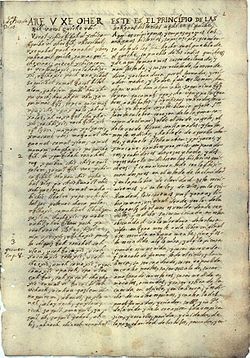Our website is made possible by displaying online advertisements to our visitors.
Please consider supporting us by disabling your ad blocker.
Popol Vuh

Popol Vuh (also Popul Vuh or Pop Vuj)[1][2] is a text recounting the mythology and history of the Kʼicheʼ people of Guatemala, one of the Maya peoples who also inhabit the Mexican states of Chiapas, Campeche, Yucatan and Quintana Roo, as well as areas of Belize, Honduras and El Salvador.
The Popol Vuh is a foundational sacred narrative of the Kʼicheʼ people from long before the Spanish conquest of the Maya.[3] It includes the Mayan creation myth, the exploits of the Hero Twins Hunahpú and Xbalanqué,[4] and a chronicle of the Kʼicheʼ people.
The name "Popol Vuh" translates as "Book of the Community" or "Book of Counsel" (literally "Book that pertains to the mat", since a woven mat was used as a royal throne in ancient Kʼicheʼ society and symbolised the unity of the community).[5] It was originally preserved through oral tradition[6] until approximately 1550, when it was recorded in writing.[7] The documentation of the Popol Vuh is credited to the 18th-century Spanish Dominican friar Francisco Ximénez, who prepared a manuscript with a transcription in Kʼicheʼ and parallel columns with translations into Spanish.[6][8]
Like the Chilam Balam and similar texts, the Popol Vuh is of particular importance given the scarcity of early accounts dealing with Mesoamerican mythologies. After the Spanish conquest, missionaries and colonists destroyed many documents.[9]
- ^ Modern Kʼicheʼ: Poopol Wuuj reads Mayan pronunciation: [ˈpʰoːpʰol ˈʋuːχ])
- ^ Hart, Thomas (2008). The Ancient Spirituality of the Modern Maya. UNM Press. ISBN 978-0-8263-4350-5.
- ^ Christenson, Allen J. (2007). Popol vuh : the sacred book of the Maya (Oklahoma ed.). Norman: University of Oklahoma Press. pp. 26–31. ISBN 978-0-8061-3839-8. Retrieved 29 September 2017.
- ^ Junajpu and Xbʼalanke in Modern Kʼicheʼ spelling
- ^ Christenson, Allen J. (2007). Popol Vuh: the sacred book of the Maya (Oklahoma ed.). Norman: University of Oklahoma Press. p. 64. ISBN 978-0-8061-3839-8. Retrieved 3 November 2017.
- ^ a b "Popol Vuh AHA". www.historians.org. American Historical Association. Retrieved 3 November 2017.
- ^ "Popol Vuh - The Sacred Book of The Mayas". www.vopus.org. VOPUS. Retrieved 3 November 2017.
- ^ According to Allen Christenson, the mat was a common Maya metaphor for kingship (such as "throne" in English) and national unity.
- ^ Christenson, Allen J. (2007). Popol Vuh : the sacred book of the Maya (Oklahoma ed.). Norman: University of Oklahoma Press. p. 21. ISBN 978-0-8061-3839-8. Retrieved 3 November 2017.
Previous Page Next Page


